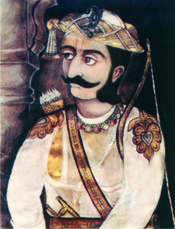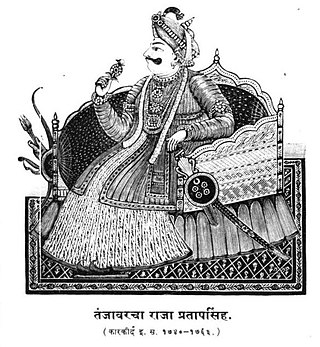Background
The Carnatic held little interest for Bajirao I, who was focused on Northern India. In his 1731 agreement with Nizam-ul-Mulk, Bajirao Ipromised to allow the Nizam free rein in the South if he gained the same in the North. However, his son could not afford to ignore the Carnatic, as Shahu might appoint rivals like Raghoji and his supporters to manage the region. Nana Saheb was determined to prevent Raghoji or Babuji Naik from gaining power there. The Karnatic already included the Maratha states of Tanjore and Gutti, with the former ruled by a branch of Shahu's family and the latter by Murari Rao Ghorpade. The region had five Nawabships—Karnool, Kudappa, Suvanoor, Shera, and Arcot—along with various European settlements. The Nizam's authority was mostly symbolic, and the Carnatic was fragmenting into competing states. [1] [2] [3] [4] [5]
By 1740, rivalry between the English and the French intensified. The Carnatic was rich and fertile, with rivers like the Krishna, Tungabhadra, and Bhima, making it a valuable region that Nana Saheb was keen to control, especially given its internal divisions and weakness. When Baji Rao showed no interest in leading an expedition to the Carnatic, Shahu tasked Raghoji I and Fatteh Singh Bhonsla with the mission. Shahu's concern for the region stemmed from repeated pleas for help from Raja Pratap Singh of Tanjore, who faced a threat from Chanda Saheb. Shahu was determined not to let the Tanjore branch of his family be destroyed, so he sent Raghoji and Fatteh Singh to intervene. Murari Rao Ghorpade of Gutti provided loyal support for the expedition. [1] [2] [3] [4] [5]
Battle
In early 1740, the Marathas entered the carnatic and by April had ravaged parts of the Arcot province. On May 15, Pondicherry received reports that a large force of Maratha cavalry, numbering between 40,000 and 50,000, had advanced on Kandanur. After extorting 60,000 to 70,000 rupees from the local inhabitants, they marched towards Cuddapah, burning villages and plundering the countryside. This prompted the local population to seek refuge in fortified cities and in the protection of the French at Pondicherry. Even the wives and female relatives of the Nawab of Arcot had to be sent there for safety. In response, Nawab Dost Ali Khan attempted to drive the Marathas out and confronted them at the Damalcherry pass on May 20. A fierce battle ensued, resulting in the Nawab's and his son Hussain Ali's death and the capture of Mir Asad. Around this time, news of Baji Rao's death reached the area, prompting Raghoji and Babuji Naik to rush to Satara to have Babuji Naik appointed as the new Peshwa. [1] [2] [3] [4] [5]
Aftermath
Despite the unexpected turn of events, Chanda Sahib remained steadfast in his defense. He placed his hopes in his brother, Bara Sahib, and urgently sought his assistance. Bara Sahib quickly responded, leading an army of 3,000 cavalry and 7,000 infantry to Trichinopoly. However, the Marathas, aware of Bara Sahib's movements, intercepted him with a force of 20,000, resulting in a fierce battle where Bara Sahib was killed. His sudden death significantly impacted his troops, who struggled in his absence and realized the extent of his leadership. As Chanda Sahib faced increasing isolation and dwindling resources, his resolve was tested to the limit. Ultimately, the harsh realities of the prolonged siege and scarce supplies compelled him to surrender. After withstanding the relentless assault for over three months, he reluctantly opened the gates of Trichinopoly on March 21st, accepting the stringent terms imposed by the Marathas. [1] [2] [3] [4]

The Maratha Confederacy, also referred to as the Maratha Empire, was an early modern polity in the Indian subcontinent. It comprised the realms of the Peshwa and four major independent Maratha states often subordinate to the former. It was established in 1674 with the coronation of Shivaji as the Maratha Chhatrapati and recognised by Emperor Bahadur Shah I as a tributary state in 1707 following a prolonged rebellion. Following this, the Marathas continued to recognise the Mughal emperor as their nominal suzerain, similar to other contemporary Indian entities, though in practice, imperial politics at Delhi were largely influenced by the Marathas between 1737 and 1803.

The Carnatic region is the peninsular South Indian region between the Eastern Ghats and the Bay of Bengal, in the erstwhile Madras Presidency and in the modern Indian states of Tamil Nadu and southern coastal Andhra Pradesh. During the British era, demarcation was different and the region included current day Karnataka and the whole region south of the Deccan.

Mirza Nasir-ud-Din Muḥammad Shah was the thirteenth Mughal emperor from 1719 to 1748. He was son of Khujista Akhtar, the fourth son of Bahadur Shah I. After being chosen by the Sayyid Brothers of Barha, he ascended the throne at the young age of 16, under their strict supervision.

Balaji Baji Rao, often referred to as Nana Saheb I, was the 8th Peshwa of the Maratha Confederacy. He was appointed as Peshwa in 1740 upon the death of his father, the Peshwa Bajirao I.

The Carnatic Sultanate was a kingdom in South India between about 1690 and 1855, and was under the legal purview of the Nizam of Hyderabad, until their demise. They initially had their capital at Arcot in the present-day Indian state of Tamil Nadu. Their rule is an important period in the history of the Carnatic and Coromandel Coast regions, in which the Mughal Empire gave way to the rising influence of the Maratha Empire, and later the emergence of the British Raj.

Muhammad Ali Khan Wallajah, or Muhammed Ali, Wallajah, was the Nawab of the Carnatic from 1749 until his death in 1795. He declared himself Nawab in 1749. This position was disputed between Wallajah and Chanda Sahib. In 1752, after several clashes, Chanda Sahib's forces and his French allies were expelled from Arcot, officially declaring Wallajah as Nawab on 26 August 1765. His reign was recognised by Mughal emperor Shah Alam II.

Chanda Sahib was a subject of the Carnatic Sultanate between 1749 and 1752. He was the son-in-law of the Nawab of Carnatic Dost Ali Khan, under whom he was a Dewan. An ally of the French, he was initially supported by Joseph François Dupleix during the Carnatic Wars. He annexed the Madurai Nayaks and was declared Nawab, bringing Tanjore and Tinnevelly into the dominions of the Mughal Empire.
Ali Dost Khan, often referred to as Dost Ali Khan, was the Nawab of the Carnatic from 1732 to 1740. He was the son of Ghulam Ali Khan, brother of the Nawab Saadatullah Khan. His childless uncle adopted him as heir, and he succeeded his uncle in 1732, he successfully gained the investiture and an official Firman by the Mughal Emperor Muhammad Shah.
Sa'adatullah Khan II a.k.a. Muhammad Sayyid was Nawab of Arcot, who was a younger son of Safdar Ali Khan.
Bangaru Thirumala Nayaka, also known as Bangaru Tirumala and Vangaru Thirumala, was a member of Madurai Nayak royal family and Governor/Commander of the Madurai Nayak King Vijaya Ranga Chokkanatha (1704–1731). His son, a young boy was adopted and crowned to the Madurai Throne, with the queen Meenakshi as queen regent, when the Madurai king died without heir. Strife between Bangaru Thirumala and queen Meenakshi would later erupt into many battles leading to the downfall of the dynasty. Later, through marriage alliances with the Sinhalese royalty, relatives of Bangaru Thirumala came to rule the Kandy kingdom in Sri Lanka. They ruled till 1815 when the last king, Sri Vikrama Rajasinha was deposed and taken captive by the British. He was exiled to Vellore Fort from Kandy.

Raghuji I was a Maratha general of the Bhonsle clan who established the Nagpur Kingdom in much of east-central India during the reign of Chhatrapati Shahu I. His successors ruled the kingdom until 1853.

Pratap Singh Bhonsle or Pratapsinha was the Maratha ruler of Thanjavur of the Bhonsle dynasty from 1739 to 1763. His rise to power followed three years of anarchy and civil war and restored the state to its previous greatness. His reign witnessed the Carnatic Wars and the Seven Years' War.

The siege of Arcot took place at Arcot, India between forces of the British East India Company led by Robert Clive allied with Muhammad Ali Khan Wallajah and forces of Nawab of the Carnatic, Chanda Sahib, allied with the French East India Company. It was part of the Second Carnatic War.
The Siege of Trichinopoly took place in early 1741 during an extended series of conflicts between the Nawab of Arcot and the Maratha Confederacy for control over parts of what is now southern India. Raghuji Bhonsle's Maratha Army successfully starved out the town, compelling the surrender of Chanda Sahib on 26 March 1741.

The Siege of Trichinopoly was part of an extended series of conflicts between the Nizam of Hyderabad and the Maratha Empire for control of the Carnatic region. On 29 August 1743, after a six-month siege, Murari Rao surrendered, giving Nizam ul Mulk (Nizam) the suzerainty of Trichinopoly. By the end of 1743, the Nizam had regained full control of Deccan. This stopped the Maratha interference in the region and ended their hegemony over the Carnatic. The Nizam resolved the internal conflicts among the regional hereditary nobles (Nawabs) for the seat of governor (Subedar) of Arcot State, and monitored the activities of the British East India company and French East India Company by limiting their access to ports and trading.

The siege of Trichinopoly (1751–1752) was conducted by Chanda Sahib, who had been recognized as the Nawab of the Carnatic by representatives of the French East India Company, against the fortress town of Tiruchirappalli, held by Muhammed Ali Khan Wallajah.

Tiruchirappalli is believed to be of great antiquity and has been ruled by the Early Cholas, Mutharaiyars Early Pandyas, Pallavas, Medieval Cholas, Later Cholas, Later Pandyas, Delhi Sultanate, Ma'bar Sultanate, Vijayanagar Empire, Nayak Dynasty, the Carnatic state and the British at different times. The archaeologically important town of Uraiyur which served as the capital of the Early Cholas is a Neighborhood of Tiruchirapalli.
Murari Rao Ghorpade (1699-1779), known simply as Murari Rao, was an army general in the Maratha Army from Gooty who administered the fort of Tiruchirappalli and surrounding areas from 1741 to 1743. His administration marks the only period of Maratha occupation in Tiruchirappalli. Murari Rao occupied Tiruchirappalli at the head of a strong Maratha army after defeating and imprisoning the Carnatic general Chanda Sahib. However, he was forced to relinquish the fort by Asaf Jah. The Nizam sieged Trichinopoly for four months, and after receiving no reinforcements, Murari Rao was eventually bought off by the Nizam and handed the fort over to him on 29 August 1743. Murari Rao was a disciple and an ardent devotee of Satyabodha Tirtha Swami of Uttaradi Matha. Murari Rao Ghorpade was the founder of the Ghati Subramanya Temple and the Makalidurga Fort.

The Battle of Ambur was the first major battle of the Second Carnatic War.
Nizam-ul-Mulk established his authority in Karnataka, while Chanda Saheb rose to prominence. Shahu appointed Raghuji Bhonsle and Fateh Singh to collect tribute from Karnataka and protect the Tanjore region against Chanda Saheb. Raghuji and Fateh Singh advanced on Arcot, where Dost Ali Khan fell fighting the Marathas. His son, Safdar Ali, sought refuge in Vellore, and the valuables of the Nawab were sent to Pondicherry.













